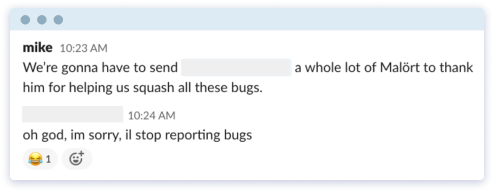🤦♂️ Facepalm Lesson One: The Delayed Aha Moment

Mike Maxey
Quick background. Smallstep is building a product-led go-to-market. This approach can be amazingly powerful when done correctly and has produced some of the world's strongest performing companies. The core concept is the organic adoption of products, not sales adoption of products. It worked for Zoom, Slack, Calendly, Expensify, Dropbox, Hubspot, and many others. Our product launch looked to emulate these companies but fell short in a few key areas. This is the first in a series of posts highlighting a few of the go-to-market mishaps we are making here at Smallstep. Yes, you read that right, a blog series on where we went sideways and some suggestions on how to avoid them in your world.
So let’s get started. First up, 'making your users wait forever for that aha moment.' Or to put a positive spin on it, 'filtering users to only the truly dedicated through an involved onboarding process'. But before we get into that, a quick summary of what you might have missed.
How Did We Get Here?
It started with a zinger of a blog post from Mike Malone that set the direction for what was to become our first product. The post created a strong reaction that we parlayed into over 100 good discussions with would-be users. We quickly formulated an MVP and shared the details with the team. To prove we could do it, we spent a day building a throwaway prototype. With a prototype in hand, we set out demoing the product to anyone that would listen. The reactions were SUPER positive and translated into a good number of early access users to help prove out the value. We love our early access users. They helped more than they know and quickly became friends. Plus they gave us direct and honest feedback:
 About Malort
About Malort
With our core functionality in place and real-world users pushing us to build the best product, we focused on the final mile, onboarding. We created user self-service. No sales calls or required professional services, just try it and find your aha moment.
The aha moment is that point in the process where the user comprehends the value you are delivering. It’s the answer to ‘what’s the point?’. You will know the reaction when you see it. Again, our early access users said it best:

The team worked overtime, pushed hard, and delivered the complete package. BOOM! We were ready.
Build It And They Will Come
With Smallstep SSH ready to go, we launched it on the world and opened up registrations. We timed our announcement with strong content marketing and delivered a healthy return. With the help of hacker news, we posted over 50,000 website views in the first 30 days. This translated to an encouraging number of signups and helped to validate our early market conversations.

We built it, they came, but it wasn’t converting as we had hoped. We searched to find out if our signup conversion numbers were good. What we found was, as always, “it depends”. Open View Partners recently published some benchmarks, and Unbounce has some good statistics, but mapping that to our world isn’t a direct correlation. For example, do you count someone from hacker news who reads a blog then exits as a ‘website visitor’? If you do, our ratios suck because we are killing it in content marketing (more on that in a future post). If not, our signup flow and conversation ratios look great. The reality is probably somewhere in the middle.
Time passed, and we collected more information. With some history across a large number of signups, we started analyzing the onboarding effectiveness. How many people were getting to the aha moment? It wasn’t a number we liked. Our onboarding process needed improvement.
🤦♂️ to 🏌️ - Instant aha!
We went back and examined the onboarding flow we created in our sprint to general availability. We also dug into the Heavybit library and a few other sources. What became clear in our reflection and research is that we made a few mishaps. And there was one in particular that we wanted to fix ASAP.
Our biggest mishap was that it took too much effort to get to the aha moment. For Smallstep SSH, the aha moment is when the user first performs a single sign-on SSH session. It’s what our early access user called "dope" and is the action we demonstrate to everyone we can. Our mishap was that to get to this aha moment took too much time and effort. We had built an onboarding flow, where the first step was the most involved. This involved step created a natural roadblock to engagement as only the most persistent users pushed through to the aha moment. 🤦♂️Again the team rallied. We looked critically at our flow and realized that a complete reversal would significantly close the ‘time to aha’ gap. This change had downstream impacts and required additional feature development. But not ordinary feature development, onboarding feature development. Features a paying customer will never use because once you complete the onboarding, these features are automatically disabled. Similarly, we created a ‘hello world’ SSH server in the process to check client configurations. Product-led success requires R&D investment into improving the experience for our users and accelerating their time to value.
With the team's stellar effort, we delivered on that reverse flow in a few short weeks. Today I’m proud to announce that our time to the aha moment is now under five minutes (or about sixty seconds if you already have brew installed on your mac). 🏌️
So here is the lesson. Don’t gatekeep your aha moment. The faster a user sees value, the better off you will be! Trust me. You will be thanking me for this tip later.
I can’t wait to watch the user engagement numbers unfold, and I promise to blog about it, so subscribe below to keep up with our mishaps and adventures.
Subscribe to updates
Unsubscribe anytime, see Privacy Policy


